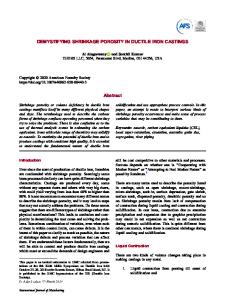Internal Porosity Defects in Ductile Cast Irons
- PDF / 4,545,223 Bytes
- 14 Pages / 595.276 x 790.866 pts Page_size
- 73 Downloads / 328 Views
Copyright Ó 2020 American Foundry Society https://doi.org/10.1007/s40962-020-00527-x
Abstract The internal porosity defects detected in four castings produced in two foundries were carefully observed and analyzed by using FE-EPMA, and then, the root cause of the defects was investigated. Based on the generally authorized theory that the internal porosities might be formed at late stage of the solidification, the experimental results are verified. The formation mechanism of dual layer and its characteristic folds or creases on inner surface of defects shown in the experimental results could not be explained by the authorized theory, but the features seem to be possible to explain when the basic films might originate on the surface of the liquid metal and might be entrained in
turbulent flow. The reductive reaction of carbon and FeO in the solid bifilms formed in the liquid metal is considered to contribute the pore nucleation in ductile iron. Therefore, in addition to the control of the process variables already developed by many researchers, the internal porosity defects in ductile cast irons using resin-bonded sand and cores might be prevented by avoiding the entrainment of carbon and oxide films.
Introduction
summarized information on the formation mechanism and process variables of the various forms of shrinkage porosities. They explained that the shrinkage porosity results from luck of compensation of contraction during liquid cooling and solidification. The compensation of the contraction in ductile cast irons is provided by graphite precipitation. So, he showed the maximization of graphite precipitation and the minimization of austenite contraction are potentially important process variables. However, his explanation did not make clear the nucleation of pore formation in the liquid metal. Many researchers have studied the effect of these important process variables, for example the carbon equivalent and chemistry requirement by Alagarsamy,2 Kanno3 and White,4 the pouring temperature by Kanno5 and the mold strength by Wallce.6 Therefore, in addition to the proper use of feeders and chills, controls were needed for many potentially important variables, including pouring temperature, residual magnesium content, suitable carbon equivalent, graphite nodule size distribution using special nodulizers,
Internal porosity defects found in the machining process are not only unacceptable as they can result in loss of strength, but also can cause a loss of customer confidence in a casting source. According to computer simulation technology, most internal porosity defects in ductile cast irons might be expected to be solved by appropriate application of feeders and chills. Even though appropriate feeders and chills were applied, internal defects are still found in ductile cast irons. Furthermore, due to move to take advantage of cost reductions from integration of several castings into a single more complex design, it often becomes difficult to install feeders in appropriate locations. So far, it has generally been as
Data Loading...










